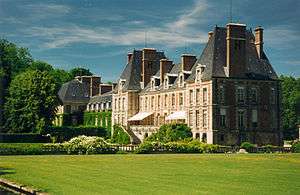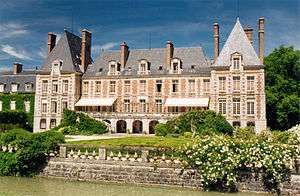Château de Courances
The Château de Courances (pronounced [ʃɑto də kuʁɑ̃s]) at Courances (Essonne) is a French château built in approximately 1630. The house and gardens are open to the public.

House
In 1552, Côme Clausse, a notary and royal secretary to the King, acquired from the Lapite family the former seigneurial dwelling at Courances, at the western edge of the Forest of Fontainebleau. His heir conveyed it in 1622 to Claude Gallard, another royal secretary, who is doubtless the builder of the present château, of an H-plan laid out on a rectangular platform that is surrounded by moat.
The original château is known from the engravings of Israël Henriet and Israël Silvestre, about 1650. The evaluation of the property drawn up in 1638 mentions, apart from the manor house, four barns, a press-house, two wheat mills, and two mills "straddling the river". "Above and beyond this is a mill called the fulling mill, with the forecourt of said chateau on one side, and the stream of the pond on the other", it says.
In the 18th century the house was modernized by Anne-Catherine Gallard, widow of Nicolas Potier de Novion, who opened up a proper cour d'honneur by demolishing the wall and entryway that had enclosed the courtyard. Later her granddaughter Léontine-Philippine de Novion and her husband Aymar de Nicolay further modernized the château (1775–1777) by opening new bays and applying a large pedimented center to each façade.
In 1830, the Nicolay heirs (see Nicolay family) conveyed away the château, which was bought in 1872 by Baron Samuel de Haber. For him the architect Gabriel-Hippolyte Destailleur restored the château in a Louis XIII style, in a campaign that lasted from 1873 to 1884. Destailleur retrieved the brickwork from beneath a layer of stucco, raised the rooflines of the pavilions and supplied zinc ornaments for the roofs. The grand internal staircase was demolished and monumental ramps of Fontainebleau inspiration were applied to the façades. A new wing with broken roofline was erected over the former kitchens to shelter the master suites, and was linked to the old wing by a gallery.
New outbuildings constructed at the same time were destroyed by fire in 1976. In the First World War, Courances served as a hospital. In the Second World War, it was first occupied by the Germans, then by Field Marshal Montgomery, serving as Chairman of the Western Union Commanders-in-Chief Committee, from 1947 to 1954.
Park

Courances has been acclaimed as "the epitome of the French formal garden style in which château and environment form a whole".[1] The garden's traditional attribution to André Le Nôtre is undocumented and dubious.[2] Actually, natural expanses of water at Courances stand in sharp contrast to the fountain machinery employed by Le Nôtre at Versailles and elsewhere. This was noted approvingly by Jacques Dulaure in the 18th century: "Nature has created this effect of ever-flowing water, an effect far superior to those pompous cascades which by mighty effort live for a moment and then die down, as if a painting were to vanish all at once from its frame".
In 1870, Destailleur transformed the park to a landscape park à l'anglaise. Of the seventeenth-century garden, some bones survived when Achille Duchêne began to remake it for the marquise de Ganay, granddaughter of baron de Haber; the grounds retained an entrance avenue of plane trees, the central allée d'honneur between flanking canals and the grand axial perspective centered on the château, with its basins and a grand canal. The marquise de Novion's eighteenth-century reflecting tank also remained.
Duchêne re-established the French garden by recreating it in novel ways, setting long straight canals in curbs of stone on either side of the central stretch of lawn, and inventing Baroque scrolling designs in clipped box set in panels of gravel. The vista leading south from the house is made to narrow in the distance, giving it an illusion that makes it appear much longer than it actually is. His also is the fountain of Aréthuse, formerly surmounted by a marble nymph that had been sculpted in 1711 by Claude Poirier for Marly. (The statue was acquired in 2005 by the Musée du Louvre).
In 1930, surprisingly, Duchêne and Mme de Ganay also created a Japanese hill-and-pond stroll garden. The park has undergone further restoration since 1948.
Notes
- Georges Lévêque, Marie-Françoise Valéry. French Garden Style. ISBN 0-7112-1061-6. Page 16.
- Thierry Mariage. The World of Andre Le Notre. University of Pennsylvania Press, 1999. ISBN 0-8122-3468-5. Page 22.
External links
- Château de Courances
